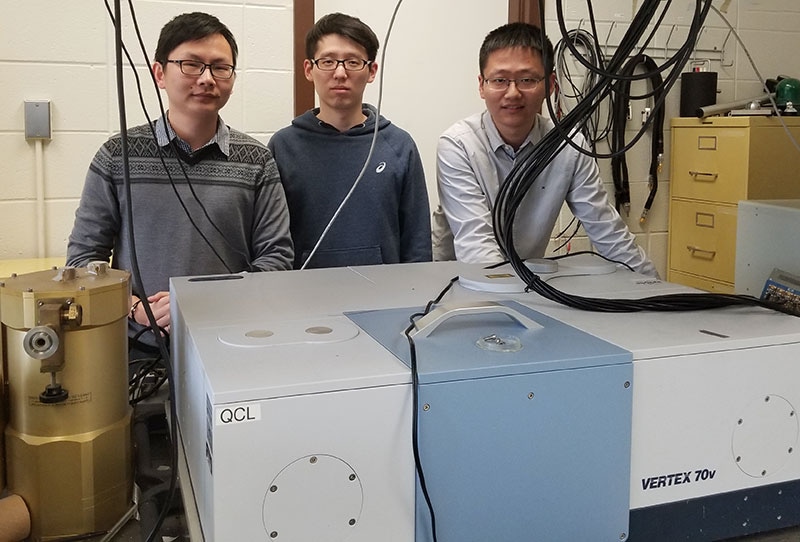May 2 2018
The capacity of harnessing light into a powerful beam of monochromatic radiation in a laser has transformed the way people live and work for over five decades. Among its numerous applications are ultrafast and high-capacity data communications, manufacturing, surgery, printers, self-driving technology, barcode scanners, and spectacular laser light displays.
Lasers also are useful in atomic and molecular spectroscopy, which are used in several branches of science as well as for the detection and analysis of a broad range of biomolecules and chemicals.
 Left to right: Research contributors and Lehigh electrical and computer engineering graduate students Ji Chen, Liang Gao and Yuan Jin stand in the Terahertz Photonics laboratory of Sushil Kumar in the Sinclair Building at Lehigh University.
Left to right: Research contributors and Lehigh electrical and computer engineering graduate students Ji Chen, Liang Gao and Yuan Jin stand in the Terahertz Photonics laboratory of Sushil Kumar in the Sinclair Building at Lehigh University.
Lasers can be classified based on their emission wavelength inside the electromagnetic spectrum, of which visible light lasers—such as those in laser pointers— are only one tiny part. Infrared lasers are utilized for optical communications through fibers. Ultraviolet lasers are employed for eye surgery. In addition, there are terahertz lasers, which are the subject of study at the research group of Sushil Kumar, an associate professor of Electrical and Computer Engineering at Lehigh University.
Terahertz lasers produce radiation that fits between microwaves and infrared light alongside the electromagnetic spectrum. Their radiation can penetrate standard packaging materials such as plastics, cardboard, and fabrics and are also strikingly effective in optical sensing and analysis of a wide range of chemicals. These lasers have the potential for use in non-destructive screening and detection of packaged explosives and illegal drugs, screening for skin cancer, assessment of pharmaceutical compounds, and even the investigation of star and galaxy formation.
Applications such as optical spectroscopy require the laser to produce radiation at a specific wavelength, which is most universally realized by implementing a method called “distributed-feedback.” Such devices are known as single-mode lasers. Requiring single-mode operation is particularly vital for terahertz lasers, as their most crucial applications will be in terahertz spectroscopy. Terahertz lasers are still in an evolving phase, and researchers worldwide are attempting to enhance their performance features to match the conditions that would make them commercially feasible.
As it spreads, terahertz radiation is absorbed by atmospheric humidity. Thus, the main requirement for these types of lasers is a strong beam such that it could be employed for optical sensing and examination of substances placed at a standoff distance of several meters or more, and not be absorbed. To achieve this goal, Kumar's research group is focused on enhancing its brightness and intensity, realizable partly by boosting optical power output.
In a new paper published in the journal Nature Communications, the Lehigh team—directed by Kumar in partnership with Sandia National Laboratories—described a simple yet effective method to improve the power output of single-mode lasers that are “surface-emitting” (in contrast to those using an “edge-emitting” configuration). Out of the two types, the surface-emitting configuration for semiconductor lasers provides unique benefits in how the lasers could be miniaturized, packaged, and verified for commercial production.
The published paper explains a new method by which a particular type of periodicity is added in the laser's optical cavity, allowing it to emit a good quality beam with increased radiation efficacy, thereby rendering the laser more powerful. The researchers call their system as having a “hybrid second- and fourth-order Bragg grating” (in contrast to a second-order Bragg grating for the common surface-emitting laser, differences of which have been used in a wide range of lasers for close to thirty years). The researchers claim that their hybrid grating system is not restricted to terahertz lasers and could enhance the performance of a wide class of surface-emitting semiconductor lasers that radiate at different wavelengths.
The report looks at experimental results for a monolithic single-mode terahertz laser having a power output of 170 milliwatts, which is the most robust thus far for such group of lasers. The study reveals conclusively that the so-called hybrid grating can make the laser radiate at a particular desired wavelength through a simple modification in the periodicity of imprinted grating in the laser's cavity while preserving its beam quality. Kumar upholds that power levels of one watt and above should be attainable with future alterations of their method - which might just be the threshold necessary to be overcome for the industry to pay attention and enter into possible commercialization of terahertz laser-based instruments.
The grants awarded from the National Science Foundation (NSF) made this research possible.